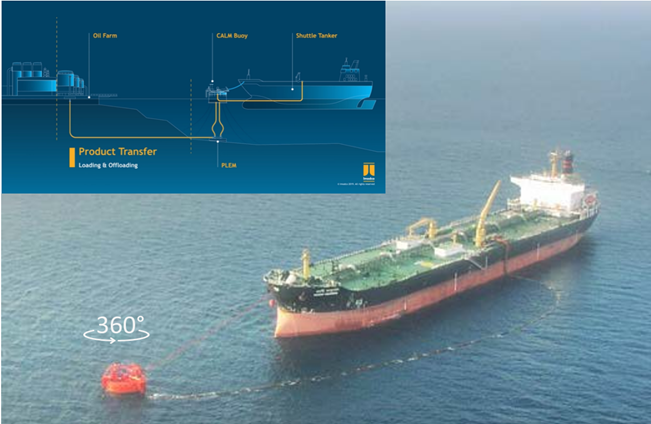
Philippe Lavagna
Terminals for New Energies – Product
Account Manager
Imodco, part of SBM Offshore Group
In this article, the author promotes the development of Imodco’s jetty-less solutions for open sea transfer of energy carrier cargo, leveraging on his experience gained over 28 years working for SBM Offshore.
The need for energy will not reduce simply because we strive to make better use of it – starting by reducing the many wastages in our present-day lifestyle and bad habits – will not compensate the larger number of persons in need of energy. Consequently, as we must reduce our GHG emissions, we will ineluctably need more renewable energies. Ideally these should be produced locally, but the storage of renewable energy remains the problem to crack. Green Hydrogen and its various vectors (called Hydrogen Carriers) are an attractive solution to store and transport Green Energy for the largest capacities over the longest durations.
Many Hydrogen Carriers (Ammonia, Methanol, most LOHC) are rather compatible with existing storage and transport infrastructure such as tankers and loading/offloading terminals. A significant step in enabling the Hydrogen economy to happen successfully is to leverage on experience wherever possible. This is particularly valid for the Green Hydrogen mega projects, for fluid cargo transfer from shore to vessels.
As a promising Green Hydrogen Hub, the Sultanate of Oman has a key role to play in the decarbonated world to come. This will require facilities to transfer Green Hydrogen cargoes from the coastline area like South of Duqm, and Ras Markaz. There are various technologies available for fluid cargo transfer from onshore storages to gas carriers in the open sea, in other words, without the need for new harbor nor expensive jetty – so these systems are called ‘jetty-less’. The experience of the fluid cargo shipping industry can be adapted to the Hydrogen economy’s new needs.
Jetty-less offloading systems have been invented over 60 years ago mainly for large oil tankers which would not fit in the existing harbors or which would need to load or offload oil or oil derivatives from a refinery away from existing infrastructures. A bit of history: for some large development projects, heavy and long-term investments were made into large jetty systems to receive these large vessels. Over the years, the experience of these large projects indicates that jetty systems typically are not only expensive but also have long delivery schedules. This is mainly due to the nature of jetty systems, especially those with breakwater, requiring many studies of the impact on the environment and the time consuming, associated permitting process. Jetty-less systems have a more straight forward permitting process and shorter overall schedule, as the simplicity of the overall system enables a virtuous spiral of simplification and cost efficiency: Jetty-less systems are conceived from day one with a view of minimum impact on the environment, including possible site reinstatement. This eases the permitting process and reduces the number of required impact studies. Finally, a shorter schedule and simpler system have combined and significant positive effect on the overall CAPEX.
Many years of operations of jetty-less systems confirm, for properly designed jetty-less systems, the overall high commercial attractiveness of the solution. The important decision for the economics is the selection of the right type of jetty-less systems:
– Conventional Buoy Mooring (CBM) are for “fixed heading” concepts where the operations are made while the vessel heading is kept in the same direction. Despite lower CAPEX, these fixed heading systems are potentially economically viable only in locations where the environment is either benign and/or directional enough to enable the required uptime. History has shown poor uptime of fixed heading concepts hence the invention of a weather-vaning concept.
– Single Point Mooring (SPM), often called CALM – see Figure 1, terminals allow the weather-vaning of the carrier during the loading/offloading operations. In other words, the operations can continue, thanks to a swivel system allowing the flow of fluid transfer even if the weather direction changes and naturally rotates the vessel heading. The relatively small delta CAPEX is quickly paid back by the higher uptime, especially in more exposed locations. This SPM concept results from cracking the problem of poor operational uptime of fixed heading solutions, since then it has become the standard with over 1,000 CALM Terminals in use worldwide.
The safety records with SPM jetty-less systems are excellent and guaranteed by the well documented regulations and guideline/recommendations (e.g. OCIMF). For most products that are in liquid form at ambient temperatures, the captains of carrier vessels are generally used to berth, load/offload, unberth from SPM jetty-less systems. This is a testament to the fact that SPM jetty-less systems are widely used for simple reasons: it works and it is cost effective (best Net Present Value for all-scale projects).
During the Green Hydrogen Summit Oman on December 7th 2022, a review of the technologies for Green Hydrogen cargo transfer in open sea will be presented and this work indicates that SPM jetty-less will provide similar results for Hydrogen Cargo Transfer in remote locations.





